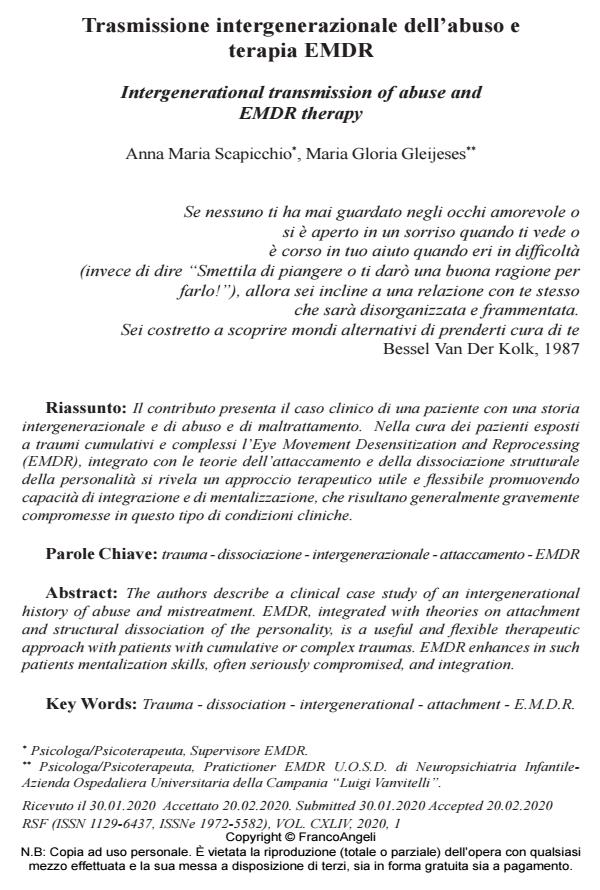Intergenerational transmission of abuse and EMDR therapy
Journal title RIVISTA SPERIMENTALE DI FRENIATRIA
Author/s Anna Maria Scapicchio, Maria Gloria Gleijeses
Publishing Year 2020 Issue 2020/1 Language Italian
Pages 12 P. 79-90 File size 170 KB
DOI 10.3280/RSF2020-001006
DOI is like a bar code for intellectual property: to have more infomation
click here
Below, you can see the article first page
If you want to buy this article in PDF format, you can do it, following the instructions to buy download credits

FrancoAngeli is member of Publishers International Linking Association, Inc (PILA), a not-for-profit association which run the CrossRef service enabling links to and from online scholarly content.
The authors describe a clinical case study of an intergenerational history of abuse and mistreatment. EMDR, integrated with theories on attachment and structural dissociation of the personality, is a useful and flexible therapeutic approach with patients with cumulative or complex traumas. EMDR enhances in such patients mentalization skills, often seriously compromised, and integration.
Keywords: Trauma - dissociation - intergenerational - attachment - E.M.D.R.
- Siegel DJ. The developing mind: toward a neurobiology of interpersonal experience. New York: Guilford Press; 1999. Trad. it.: La mente relazionale. Neurobiologia dell’esperienza interpersonale. Milano: Cortina; 2001.
- Schore AN. Early organization of the nonlinear right brain and development of a predisposition to psychiatric disorders, Development and Psychopathology 1997; 9: 595-631. DOI: 10.1017/S0954579497001363
- Schore AN. Relational trauma and the developing right brain: The neurobiology of broken attachment bonds. In: Baradon T, ed. Relational trauma in infancy: Psychoanalytic, attachment and neuropsychological contributions to parent–infant psychotherapy. Routledge:Taylor & Francis Group; 2010. p. 19-47.
- Le Doux JE, Doyere V. Emotional memory processing: Synaptic connectivity, In: Nalbantian S, Matthews P, McClelland JL, ed. The Memory Process: Neuroscientific and Humanistic Perspectives. Cambridge: MIT Press; 2010. p. 153-172.
- Kandel ER. A new intellectual framework for psychiatry. American Journal Psychiatry 1998; 155: 457-69.
- Main M. Metacognitive knowledge, metacognitive monitoring, and singular (coeherent) vs. multiple (incoherent) model of attachment. In: Parkes CM, Stevenson-Hinde J, Marris P, ed. Attachment across life cycle. London-New York: Routledge; 1991.
- Main M, Goldwyn R. Adult Attachment Scoring and Classification System, manoscritto non pubblicato, Berkeley: University of California; 1985-1994.
- Fonagy P, Gergely G, Jurist L. Regolazione affettiva, mentalizzazione e sviluppo del sé. Milano: Raffaello Cortina; 2005.
- Felitti VJ, Anda RF, Nordenberg D, Williamson DF, Spitz AM, Edwards V et al. Relationship of childhood abuse and household dysfunction to many of the leading causes of death in adults: the adverse childhood experiences (ACE) study. American Journal of Preventive Medicine 1998; 14: 245-258.
- Shapiro FR. Coniage of the term information science. Journal of the Association for Information Science and Technology 1995; 46: 384-385.
- Fernandez I., Maslovaric G., Veniero G.M. Traumi psicologici, ferite dell’anima. Il contributo della terapia con EMDR. Napoli: Liguori; 2011.
Anna Maria Scapicchio, Maria Gloria Gleijeses, Trasmissione intergenerazionale dell’abuso e terapia EMDR in "RIVISTA SPERIMENTALE DI FRENIATRIA" 1/2020, pp 79-90, DOI: 10.3280/RSF2020-001006